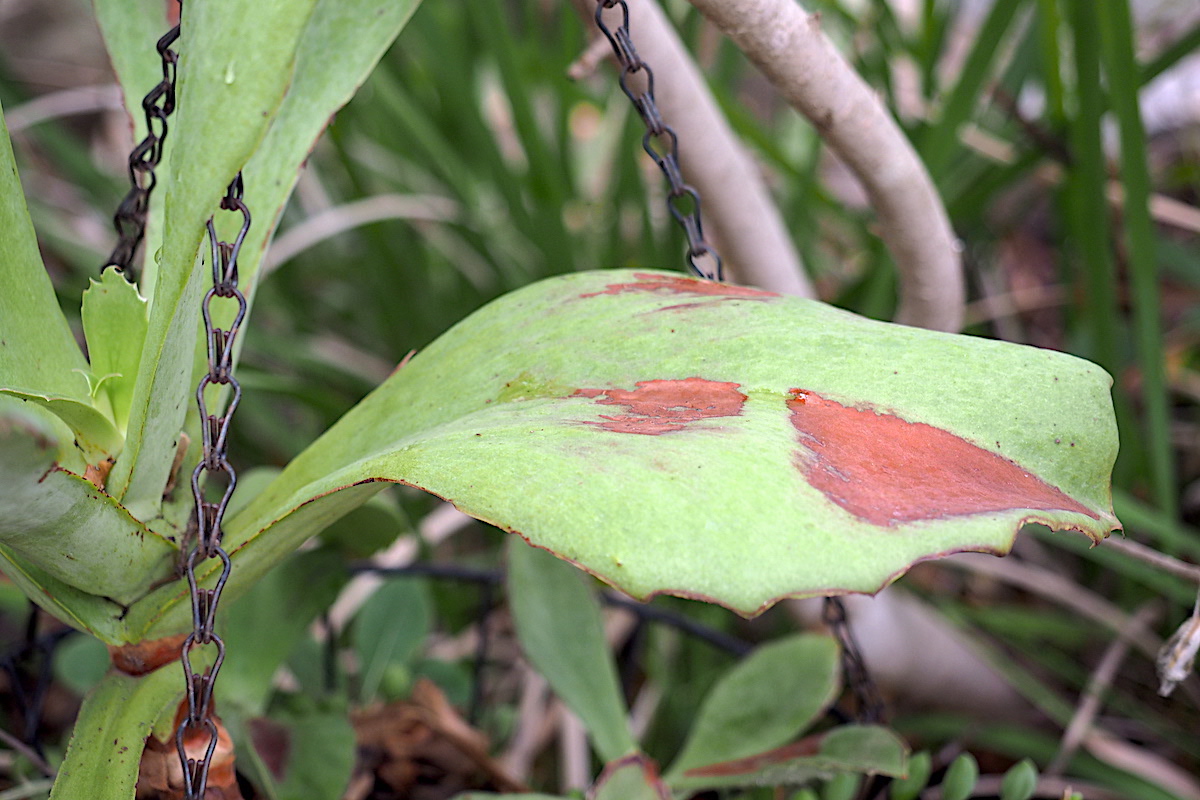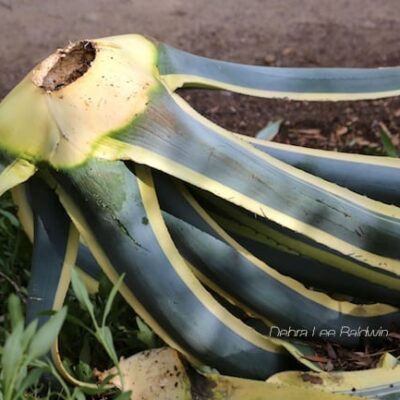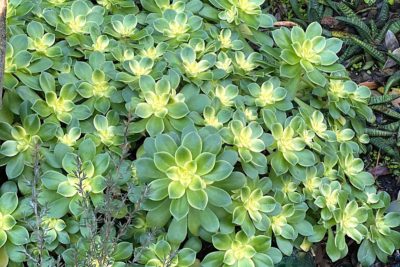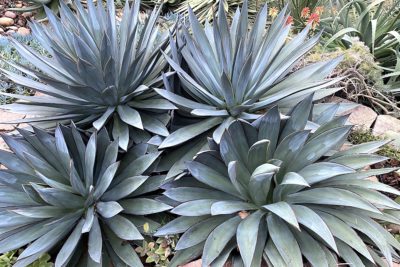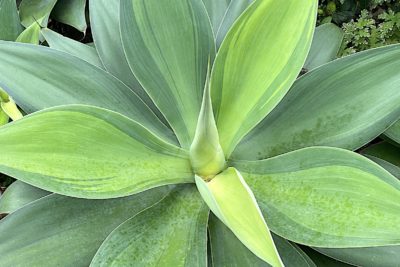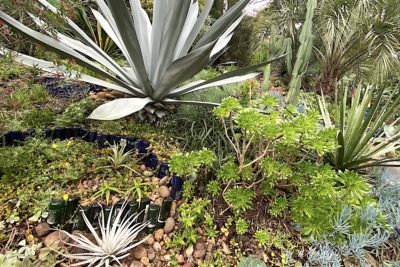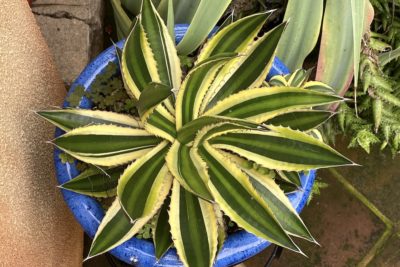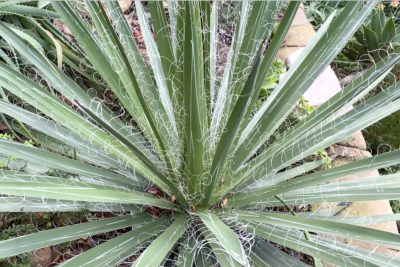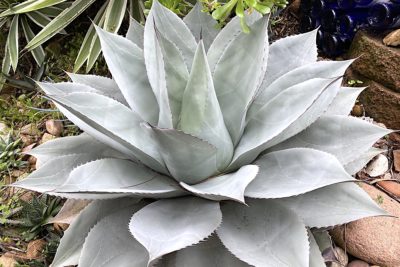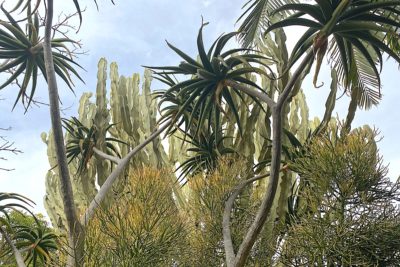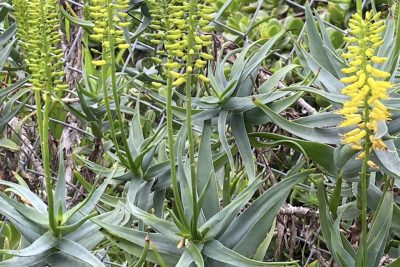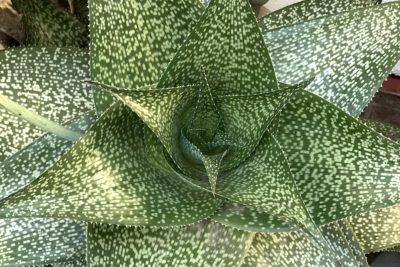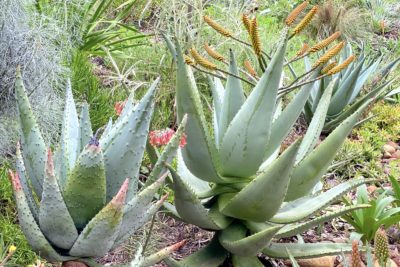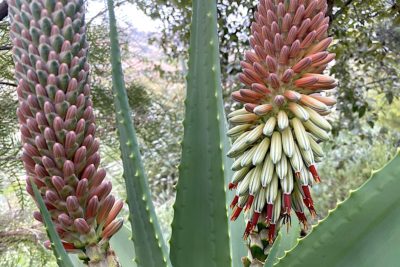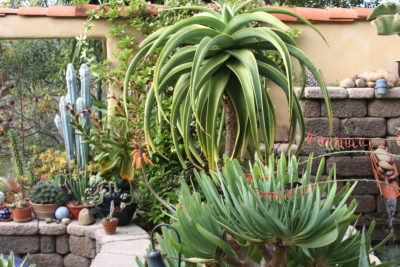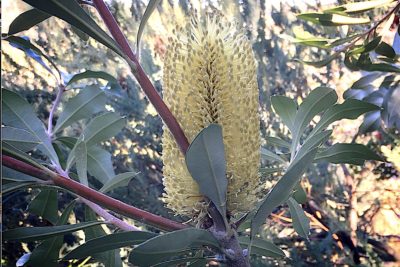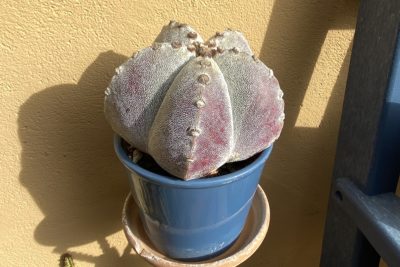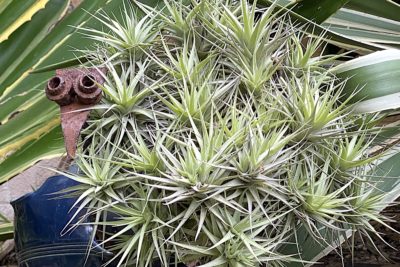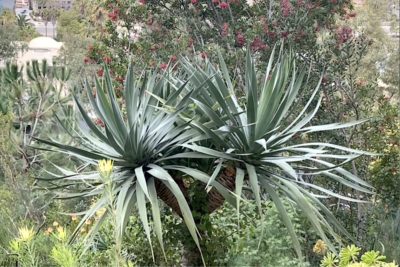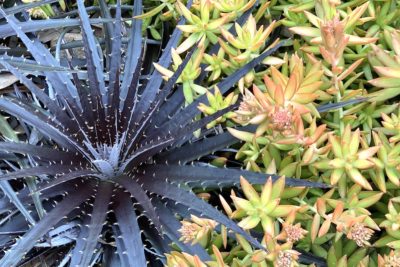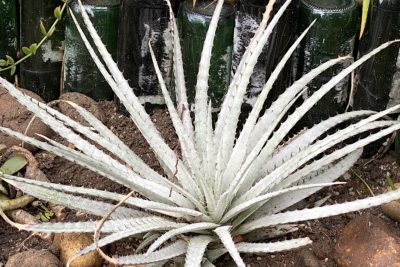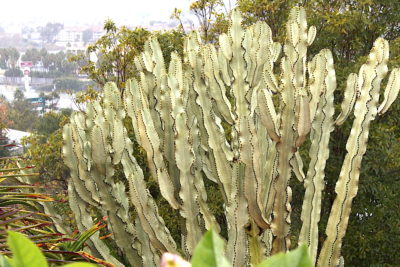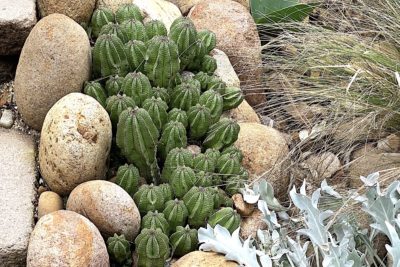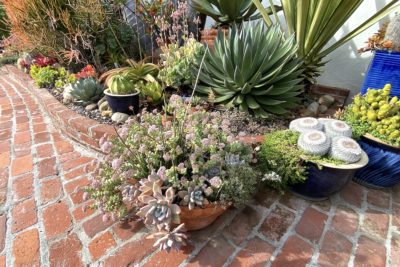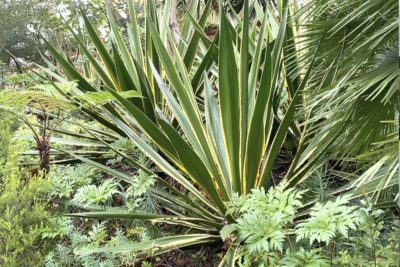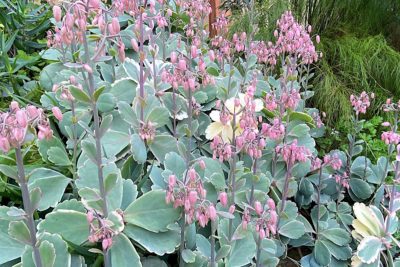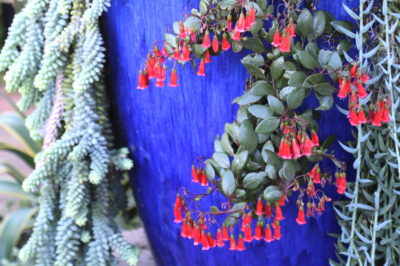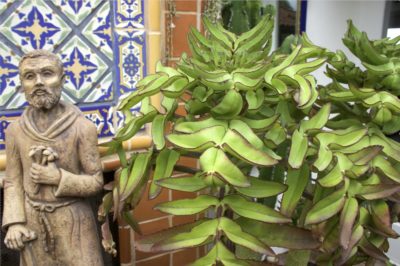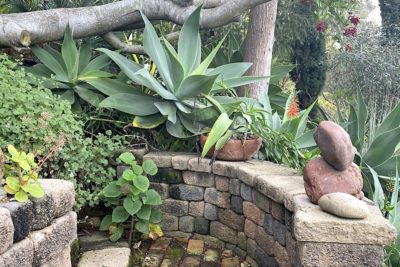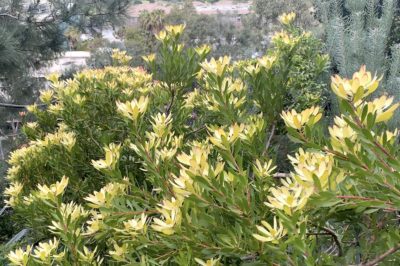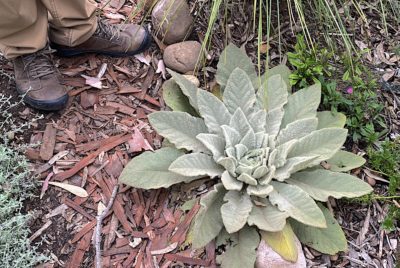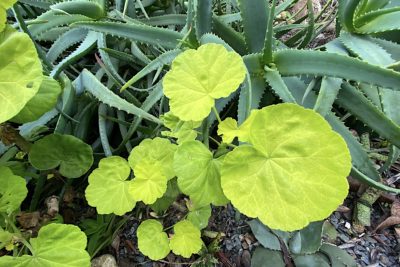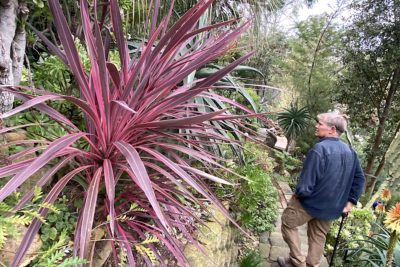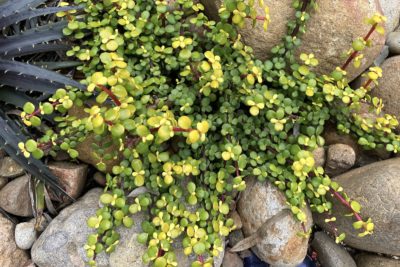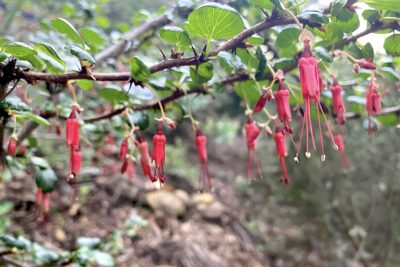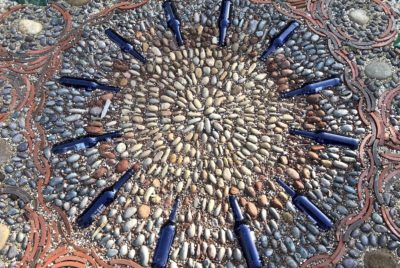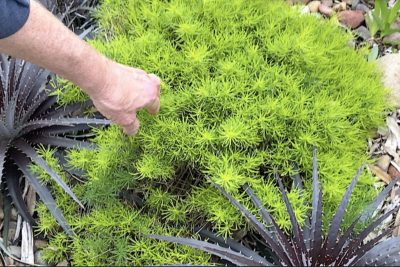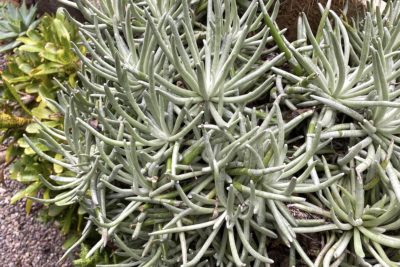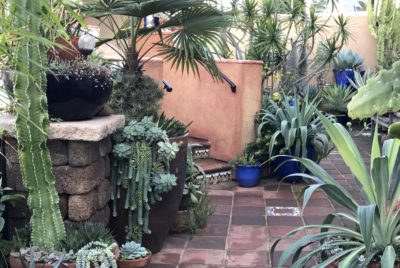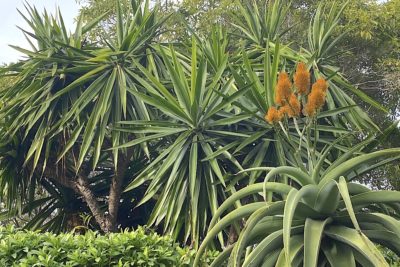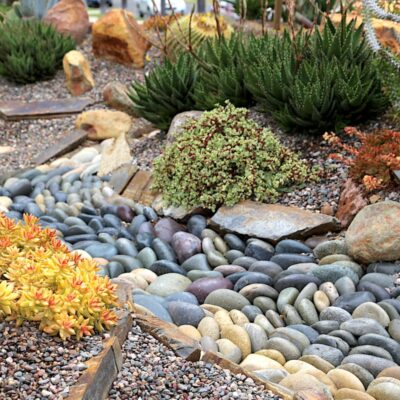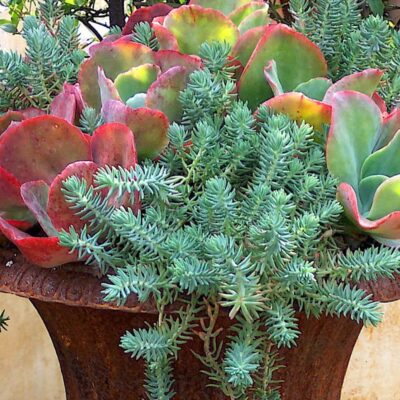Jim Bishop's steep, one-acre terraced garden in San Diego is unlike any other, except perhaps Jardin Exotique d'Èze, near Monaco, overlooking the Mediterranean.
"But there, they have to dig basins into solid rock to plant anything," recalls Jim, who has visited gardens worldwide. Not that their own garden lacks rocks. "Every time you dig a hole, you end up with a bucketful," Jim says. Because his garden is on a bluff overlooking the San Diego River valley (no surprise) his are cobbles.
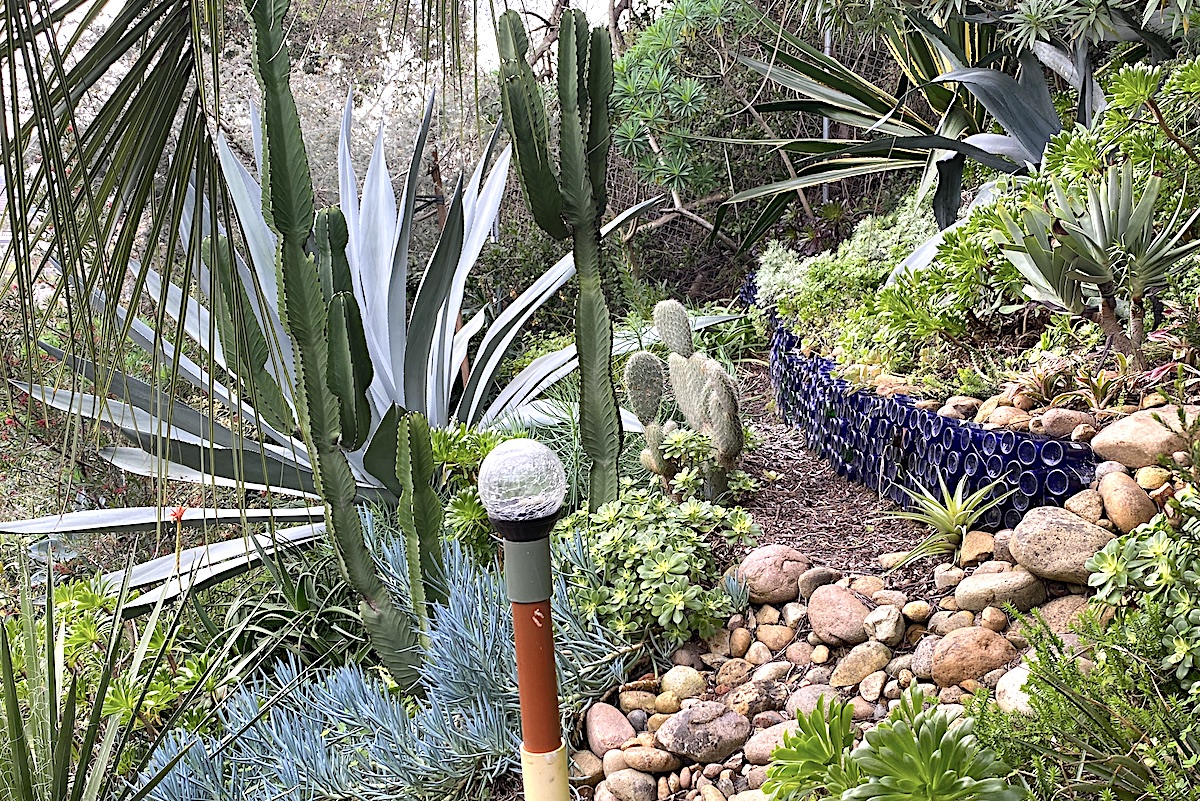
Euphorbia ammak and agaves
A Garden of Challenges
Jim, a retired garden designer and past-president of the San Diego Horticultural Society, sculpted the terrain below their 1930s Spanish colonial home over the past 22 years. He and partner Scott Borden contend with rock slides, fog that causes plants to rot, and erosion.
There's no wheelbarrow access, so they have to hand-carry tools, nursery pots and supplies. Gophers eat roots and undermine steps and landings. Only recently---the last four years---have they tackled landscaping the north-facing bluff's sunniest spot, a level area ten stories and 300+ steps below the house. "We live in Mission Hills," Jim says. "The bottom of our property is in Mission Valley."
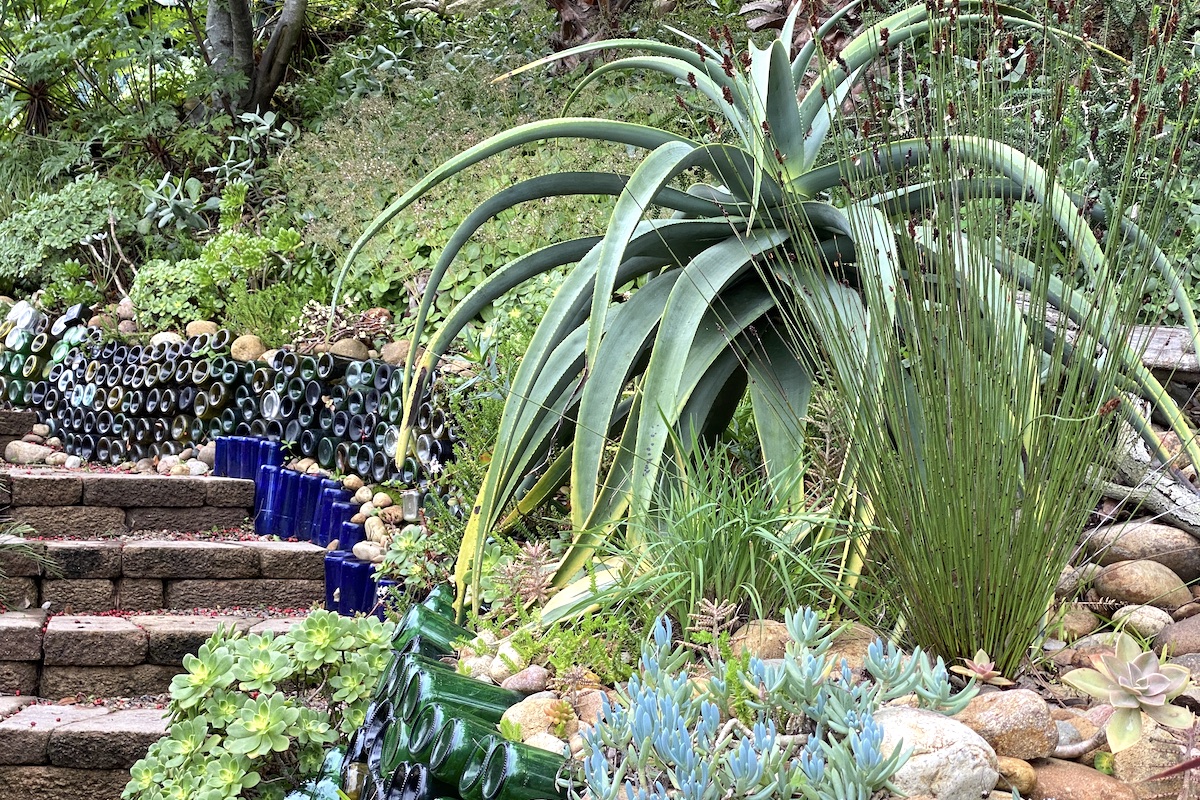
Stairs lead past a bottle retaining wall and a large Aloe thraskii
Far and wide
It's often on organized tours---not just local groups, but also visiting horticulturists, landscape architects, and garden designers. I've followed the progress of this remarkable garden for 14 years, meeting Jim and Scott when I covered it for San Diego Home/Garden magazine ("Steep Solutions: Mission Hills homeowners carve out a glorious garden," June, 2006). I've also written about it for the San Diego Union-Tribune, Better Homes & Gardens, and Sunset, and it's in all three of my succulent books.
Attention to design
Jim reminded me recently that on my initial visit, I shot more photos of potted succulents than anything else. Well, sure, back then I was working on my first book, Designing with Succulents, and a good succulent garden was golden.
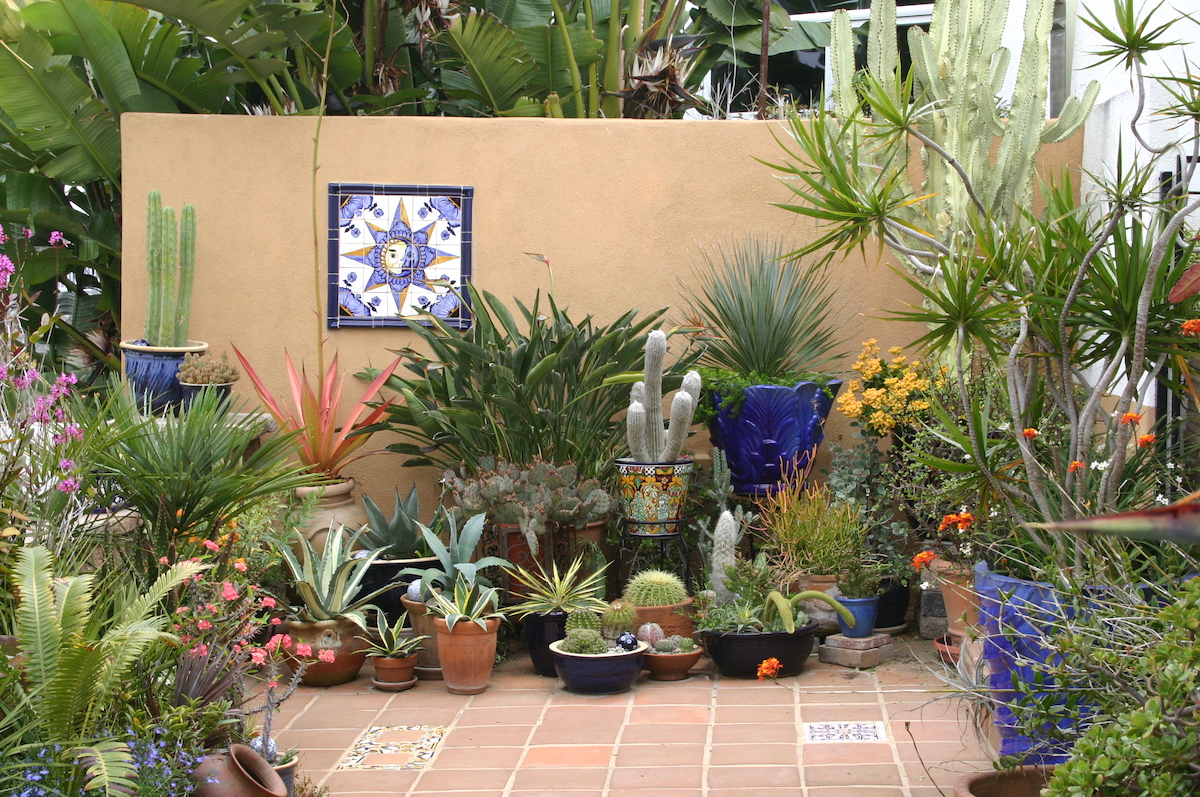
Veranda garden as shown in Designing with Succulents
When Jim saw the book's two-page spread of his veranda garden, he realized he'd overlooked a keynote of good design: pattern repetition. A wall tile's eight-pointed star might effectively have been echoed by plants with pointed leaves. So Jim switched the containers to agaves. His veranda collection now numbers 35---and that doesn't include in-ground specimens.
Plants and rocks
It's difficult to say how many different succulents, tropicals, natives and Australians grow on the property. Certainly thousands. They range from a towering Torrey pine and aloes to dainty air plants (tillandsias), vines and---where sun is adequate---cacti.
Jim is an artist as well as a plantsman, and over the decades he's developed mosaic skills. What began as cobbled landings have evolved into elaborate designs that incorporate terra-cotta roofing tiles. The latter are leftover "from when we installed solar panels," Jim says.

Mosaic of terra-cotta roofing tiles
Bottle Retaining Walls
And then there are the bottles. Jim's preferred color for garden accessories (such as ceramic glazed pots) is blue, so I'd assumed that's why all sorts of blue bottles border stairways and ornament terraces, and also hearken to the trend of repurposing. I learned recently that those were not Jim's only reasons. As he explains in the second of my videos, blocks for terraces can weigh 60 pounds. Having to carry one "five stories below the house really wears you out. But you can always carry, whenever you come down the hill, a handful of bottles."
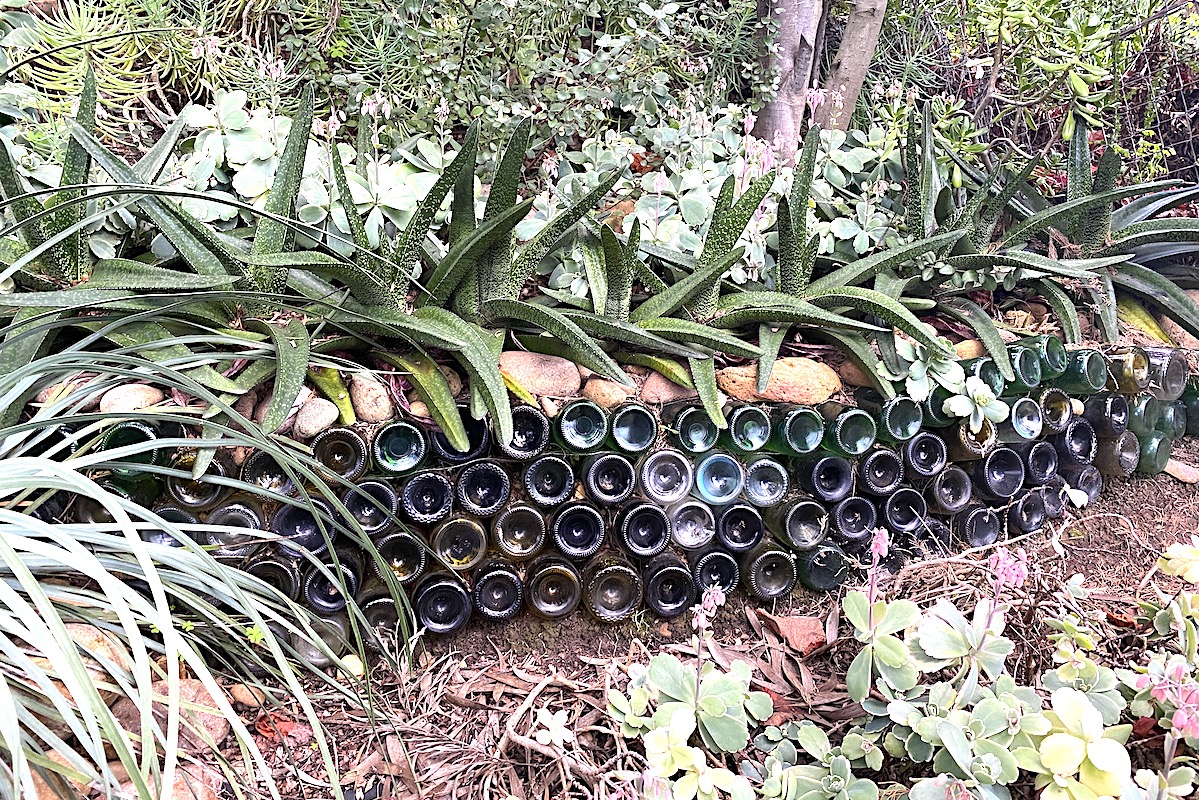
Gasteria grande atop a terrace shored up with repurposed bottles. Jim estimates there are 10,000 bottles in the garden.
bishop garden: Six Areas
The garden's distinct areas incorporate succulents as well as ornamentals that thrive in coastal San Diego's mild, often damp coastal climate. Typical of gardens that face north, this one lacks sun, especially in winter---which, Jim explains, is among his many challenges.
Streetside
This comparatively small, south-facing front garden once was roses, but "they burned in the winter," Jim says. And because of brick hardscape, much of the garden is in pots---a difficult environment for thin-leaved ornamentals...but not for succulents. The pots-atop-pavers situation also is true of the courtyard and veranda.
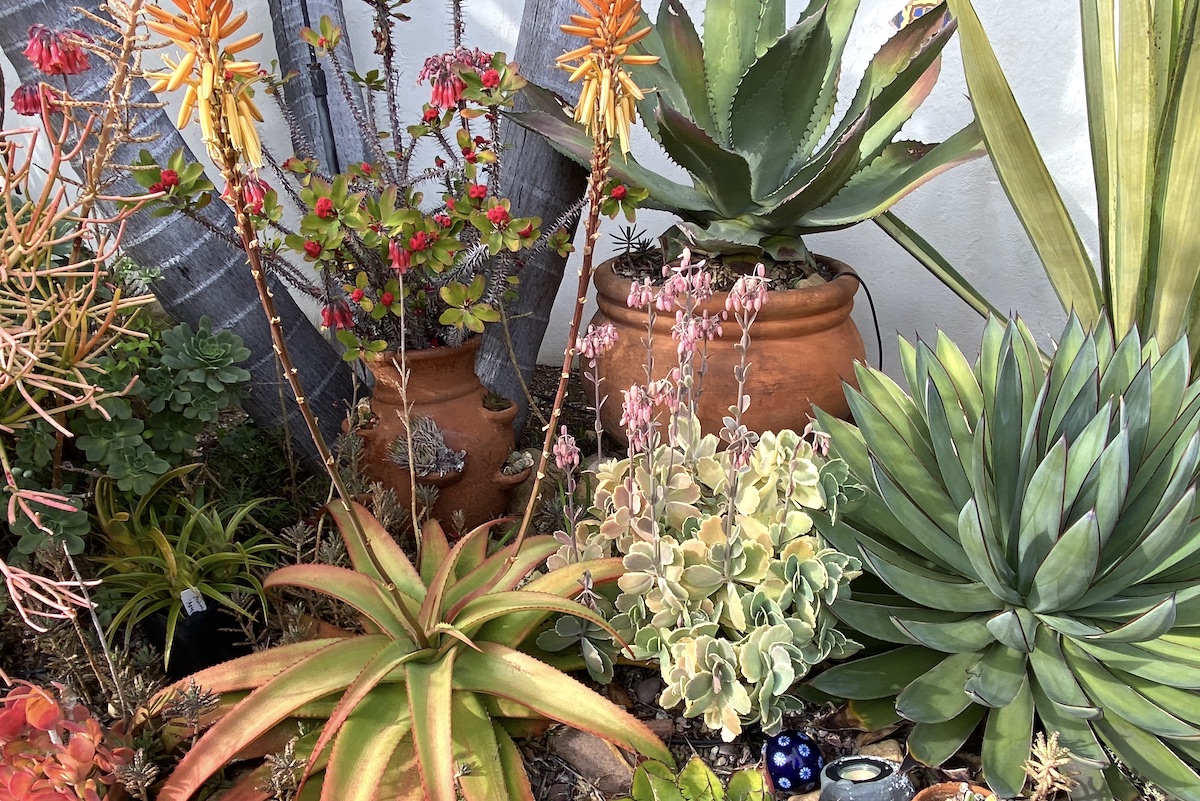
Front garden w Aloe vanbalenii, Agave 'Blue Glow'
Courtyard
A wrought-iron gate leads into a patio sheltered on three sides by the house and on the fourth by a garden wall topped by brick latticework. In gaps is Jim's tillandsia collection. Here, too, is a table for outdoor dining and an arched fountain with blue, white and yellow Mexican tiles---a stylistic note repeated throughout house and garden.
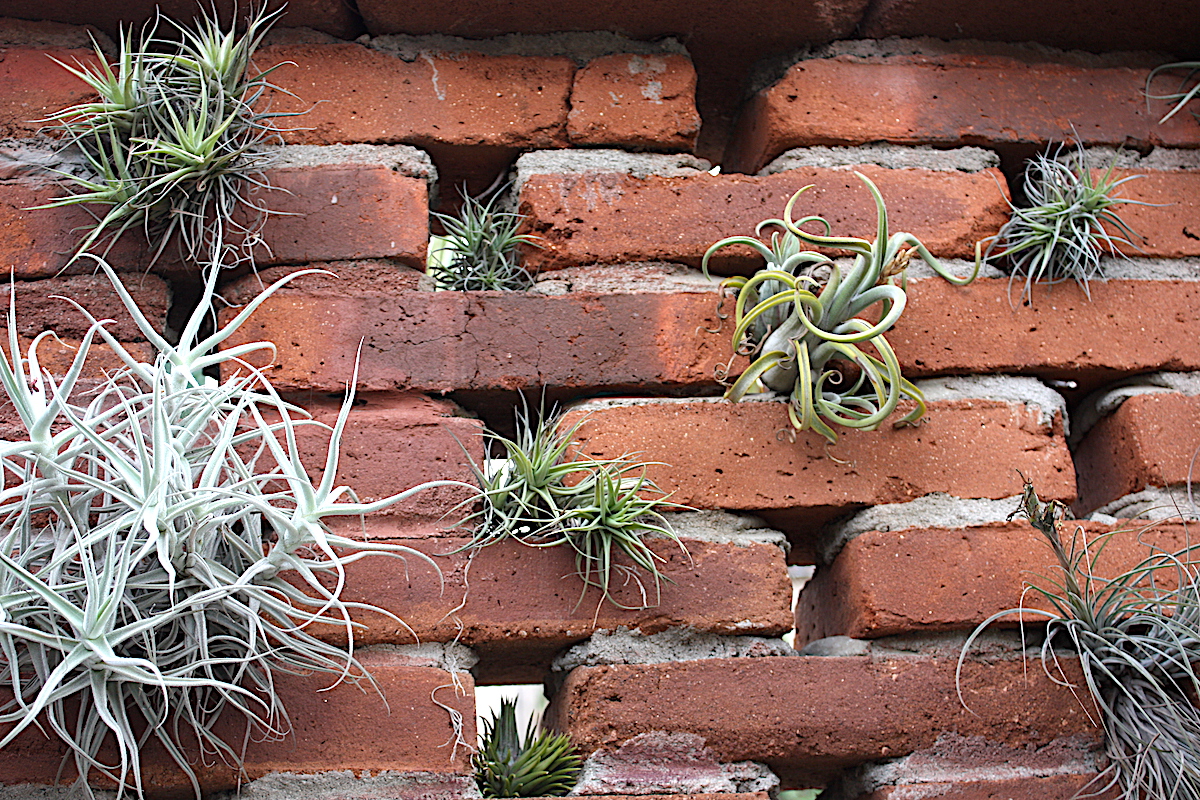
Tillandsias in bricks
Veranda
Along the home's top level is a 1,500-square-foot veranda paved with terra-cotta tiles. The 180-degree view is to the north, across Mission Valley; to the west where the river meets the sea; and to eastern foothills. The muted roar of Interstate 8 mingles with a fountain's splash. Large pots brim with plants.
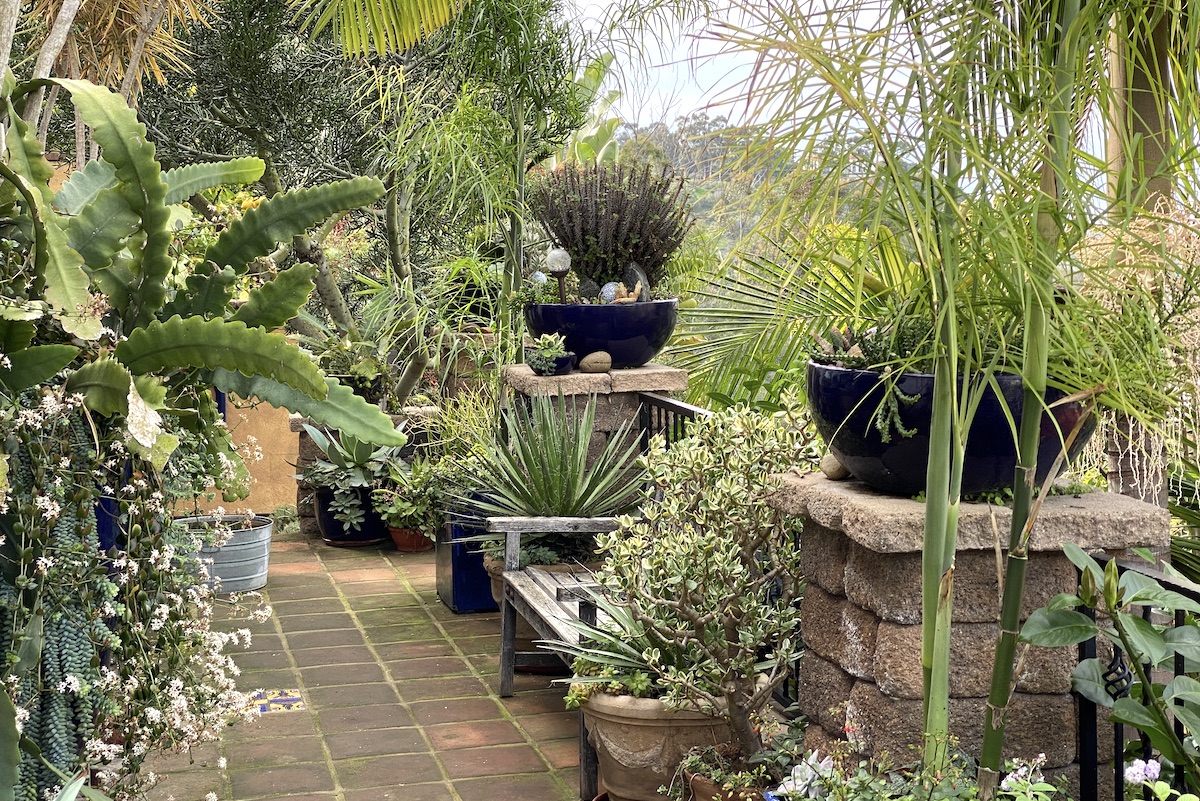
Veranda garden in winter
Walled garden
Through a tower designed by architect Marc Tarasuck during an extensive remodel 20 years ago, steps lead down to where "the coldest swimming pool on the planet" once was, Jim says. The rectangular area along the home's north retaining wall now has a thick-walled, open-air casita with archways that frame a fountain and sunken garden.
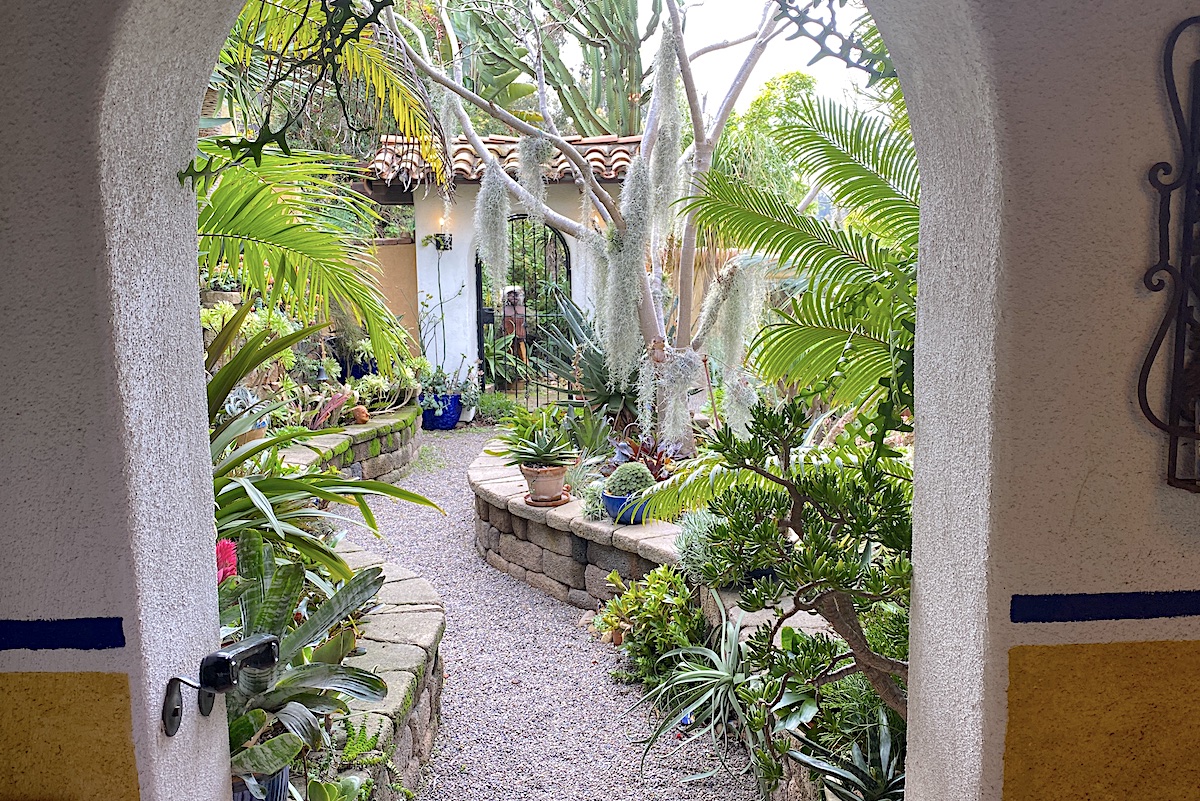
Spanish moss in walled garden
Terraced garden
The steep hillside below the house is the largest area, and half of it is native chaparral. Switchback steps weave past terraces containing a botanical garden's worth of plants, each with its own story. And no trip into Jim's garden is complete without discussing (and lamenting) gophers. "Last month I caught five," Jim says.
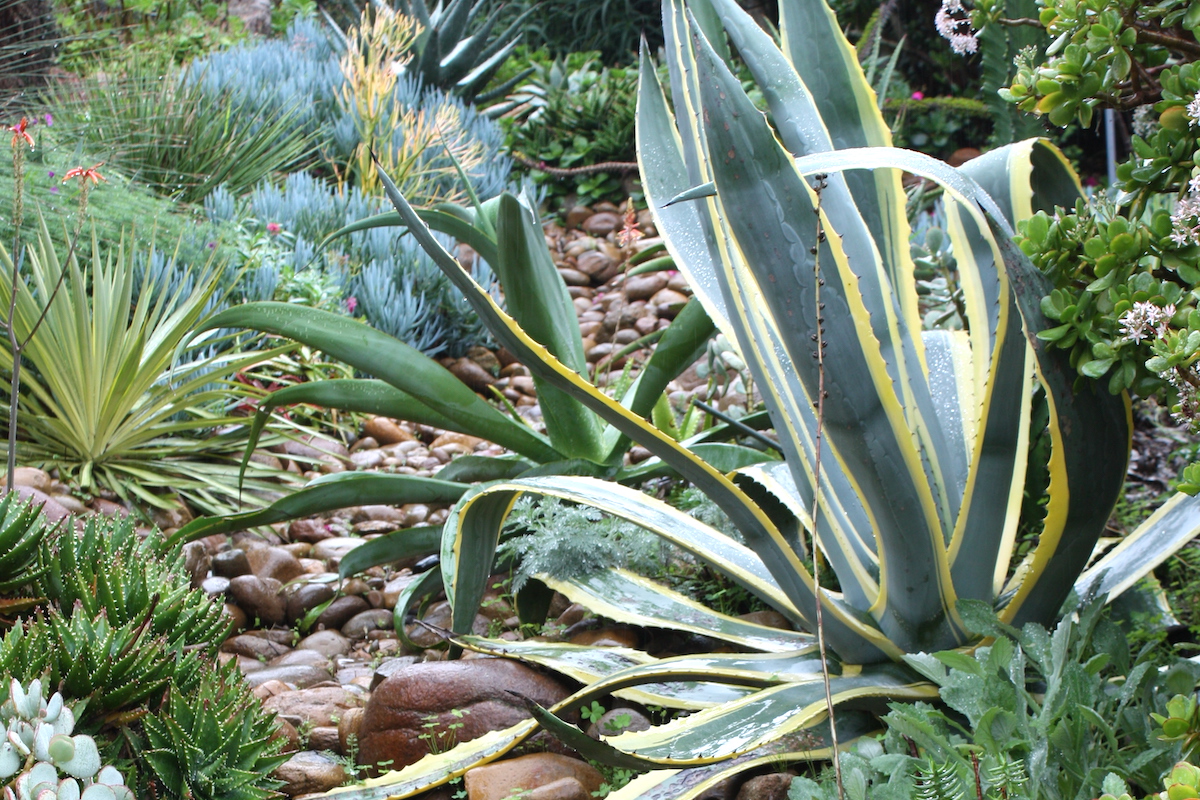
Gophers occasionally undermine large succulents, like this Agave americana 'Marginata', sending them tumbling down the hillside.
Mosaic garden
The garden's latest addition is a large mosaic mandala surrounded by cobble-filled gabions with flat stone seats. Jim's aloe garden is along the east side; his cactus garden is on the west; and between the circle and the property's northernmost fence are Australian trees Jim says will eventually conceal an adjacent hotel's parking garage.

A newly planted young Aloe 'Hercules' in the center of the mosaic mandala will eventually attain 30 feet in height.

